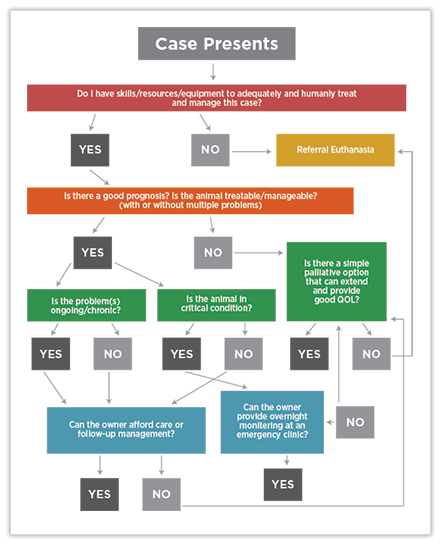Incremental veterinary care is patient-centered, experience-based medicine focused on a problem-solving approach to achieve the best possible outcomes for the family and human-animal bond in the context of limited resources. Experience-based medicine is a case management style based on the practitioner’s clinical experience and judgment relative to the management of various clinical presentations. Part of the responsibility of the veterinarian is to educate the client about the most pressing issues and guide them with allocating their money towards what is most helpful for the pet.
Incremental veterinary care is a case management strategy that utilizes the intuitive judgment of the veterinarian to develop a tiered diagnostic and dynamic therapeutic options over time approach. Non-critical procedures are avoided to help control costs. It relies on the clinical judgment of the veterinarian, active follow-up of case progression, and, when appropriate, in-home care that can be provided by the client. In addition, there is a focus on prevention, and early diagnosis and intervention.
Incremental veterinary care is a viable alternative to being unable to help the patient. In those situations where gold standard care is not possible because of financial constraints, it provides an alternative to strengthen the integrity of human-animal bond.
In the past, terms commonly used to describe this medical approach have been “empirical medicine” and “intuitive medicine.”
Incremental Veterinary Care Case Management Approach

Although it is difficult to predict every type of case that will be seen, the authors’ past experience indicates that the majority of clinical case presentations can be handled by an incremental veterinary care case management approach. Since the veterinary practitioner’s clinical judgment is primary to the success for this type of care, clinical experience and exposure to a broad ranging case load are key components to such clinical judgements.
This tiered diagnostic and dynamic therapeutic options over time approach minimizes diagnostic backup and maximizes the veterinarian’s judgment based on their past experience. Therefore, an extra emphasis is placed on the pet’s primary caregiver and veterinary team to closely monitor the clinical response of the patient, requiring a commitment of timely and accurate ongoing communication between the two.
The pet’s primary caregiver is the person who actively participates in the medical care of the pet and is committed to collaborating and coordinating with the veterinary team. The capability of the primary caregiver to communicate with the veterinary team, as well as carrying out recommendations, need to be considered when developing a treatment plan. These two factors are prognostic indicators.
Key components:
- Practical-minded approach by a veterinary practitioner
- Team medicine approach with clear communications
- Facilities and available equipment
- Trained and motivated support staff
- Client communication
- Client acceptance and compliance
- Use of new technology options (e.g., telehealth) to help lower costs
The above components are key for any veterinary practice but are particularly important for those scenarios where diagnostic backup is minimized and veterinary judgement based on experience is maximized, as is the case with incremental veterinary care, as a case management approach.
Although veterinarians may choose different parameters when dealing with a client with significant financial limitations, the following are suggested to be used for objective patient evaluation:
- Do I have the skills/resources/equipment to adequately and humanely treat and manage the case?
- Is there a good prognosis? Is it treatable? Is it manageable? Are there multiple problems?
- If it isn’t treatable or manageable, is there a simple palliative option that can extend and provide good quality of life?
- Is the problem an ongoing or chronic condition?
- Can the owners afford follow-up care or management?
- Can the owners provide overnight monitoring at an emergency clinic if it is necessary?
- Is this animal in critical condition?
- Would significant amounts of money make a difference in a positive outcome?



